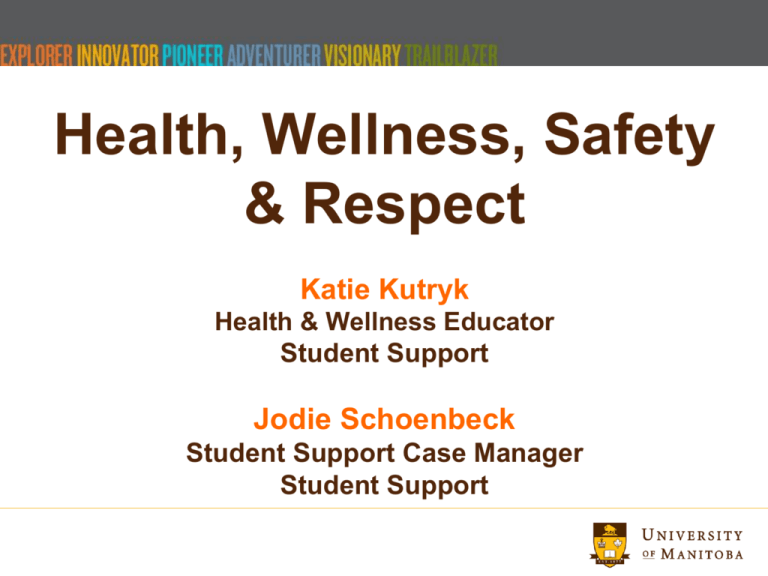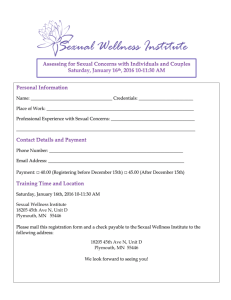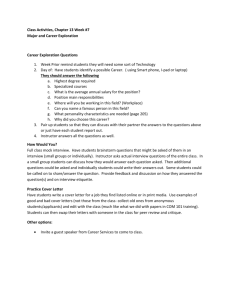
Health, Wellness, Safety
& Respect
Katie Kutryk
Health & Wellness Educator
Student Support
Jodie Schoenbeck
Student Support Case Manager
Student Support
Purpose of Our Session
• Create understanding of our roles and how they
contribute to the overall health, wellness and safety of
students and the campus community.
• To see some of the recommendations of the Mental
Health Strategy in action and what’s being done on
campus!
• To inform you of current and relevant health and
wellness priorities on our campus.
• To learn about the range of resources available on and
off campus, to empower staff members in supporting
students mental health and overall wellness.
Health and Wellness Educator Background
• Registered Nurse, College of Registered Nurses of
Manitoba
• Bachelor of Nursing, University of Manitoba
• Winnipeg Regional Health Authority: Health
Sciences Centre, St. Boniface Hospital
• Travel Health work experience
• Passion for Public Health, Health Promotion &
Prevention
Health & Wellness, University of Manitoba
• Created and Established in late 2012
• VISION
– An accessible, inclusive, supportive and sustainable
program based on evidence based health promotion and
prevention strategies.
– Intervention at individual and community level.
– A program that goes beyond just providing health information, but
rather:
• engages students in building capacity to enable an increase of
control over, and to improve their health
• Provide opportunities to engage the campus together as a whole in
creating a learning community that is healthy, supportive and safe.
Health and Wellness Role
• Health & Wellness Educator
– On going needs assessments
– Public education and program development based
on needs
– Raising awareness of student supports, on
campus and off campus resources
– Building strong partnerships with on campus and
off campus stakeholders in student health and
overall wellbeing
• Examples: Klinic Community Health Centre, Women’s
Health Clinic, Sexual Assault Nurse Examiner Program
Health & Wellness Responsibilities
• Interaction with students
– Classroom settings, workshops,
presentations, one on one.
• Resource person for staff, faculty
and external stakeholders
– Responding to student health and
wellness concerns and needs as
identified.
• Health and Wellness resource
connection
• Health Promotion Programming
– Peer Health Educator Program
– UM Health and Wellness Blog
• Public Education and Outreach
– Online presence (Facebook, ICS
Newsletter)
– Workshops & Presentations on an
Ad Hoc basis
• Sexual Health/Assault,
Consent
• Healthy Lifestyles (sleep,
physical activity, healthy eating)
• Stress Management
• Travel Health
– Pet Therapy
– Awareness building
• Committee Work
– Sexual Assault Working Group
– Alcohol Advisory Committee
– Manitoba Alcohol Strategy Group
Student Support Case Manager:
Jodie Schoenbeck, B.S.W.
Education
Bachelor of Social Work,
University of Manitoba
Professional Experience
Case Manager, Child and Family Services
Clinical Case Manager,
Marymound Treatment Foster Care
Student Support Case Management,
University of Manitoba
• Position originated in September 2013
Vision:
To provide coordinated, accessible, sustainable and practical
support, on both an individual and community level, to promote
respect, safety and well being.
Student Support Case Manager:
Role and Responsibilities
• Case Management:
Support Caseload – students experiencing ongoing distress due
to complex needs and life situations
Responsibilities:
-coordinating multiple supports of the student to create a support
team for the individual
-informing and referring students to campus and community
resources
-creating ongoing practical plans that are sustainable and fit the
unique needs of the individual (i.e. attending
-ongoing assessment of the individual’s well being
-assisting students with Authorized Withdrawals process if they
have experienced trauma or ongoing mental health needs
SSCM Roles and Responsibilities cont…
STATIS Caseload – students who have been identified as
disruptive or potentially unsafe to the
community
Responsibilities:
-identifying students/situations of concern and reporting to team
-coordinating ongoing assessments and investigations of
situations/students
-collaboratively creating interventions with STATIS and other
campus stakeholders
-providing supportive case management to the students
-educating campus community to the role and presence of STATIS
SSCM Roles and Responsibilities cont…
• Consultations:
-Available to staff, faculty and all campus stakeholders
-Through one to one email/phone calls, group meetings
-Purpose of consults is to support staff in working with distressed
students and students of concern
• Presentations:
-collaborative presentations with other student support offices on:
-empowering campus stakeholders to work with students
experiencing distress
-how to promote safety and well being on an individual/
community level
Foundation of Health and Wellness
•
•
Optimal wellness is
achieved when students
are supported in each of
these areas.
Neglecting any one area
compromises overall
health.
Responding to Needs…
Focus 2014-2015: Priority Issues
• Mental Health
• Sexual Assault
• High Risk Alcohol Consumption
• These are all relevant and growing issues for our student
population.
• You all are located on the “wheel” somewhere.
• We all contribute to the student’s life.
• We all have to be mindful of these issues, regardless of where
we work.
Vulnerable Populations
There are various student groups that may
encounter more challenges and barriers then
others in a post secondary academic
environment.
National College Health Assessment
• Conducted through Health & Wellness for the first
time in Spring 2013.
• A comprehensive survey of U of M students habits,
needs, perceptions and behaviours on the most
prevalent health topics.
• Compared to Canadian Reference Group data
• Helps understand each aspect of student wellness
• Informs programming
Mental Health
A PICTURE OF OUR CAMPUS
NCHA:
• Within the last 12 months students reported
experiencing the following:
–
–
–
–
–
–
83.0% felt overwhelmed by all they had to do
81.9% felt exhausted (not from physical activity)
60.2% felt very sad
49.4% felt overwhelming anxiety
47.3% felt things were hopeless
33.4% felt so depressed it was difficult to function
An Individual Story
•
•
•
•
A fourth year international student
Two terms of requesting AW’s for all classes
Not attending classes
Not submitting work
What was going on?
What could be done?
Establishment
of first ever
student run,
student led,
mental health
awareness,
advocacy and
education
student group
on campus.
Outreach
PET THERAPY
• Started April 2012
• Midterm and Final Exam time on Fort Garry & Bannatyne
Campuses
• One of the most popular Health & Wellness initiatives
• Handbook on Animal-Assisted Therapy: Theoretical
Foundations and Guidelines for Practice, several studies are
cited which show positive effects of interaction with animals
including: an instant decrease in blood pressure and an
increase in oxytocin (feel good hormone) (Fine, 2010).
• Research has also shown that students who interact with
therapy dogs report significantly lower levels of anxiety
(Morgan, 2008).
Outreach Continued
• Awareness building
• Gold Card
• Presentations
• Workshops
Strategically Moving Forward…
•
•
•
•
Meeting Students Where They are At
Current Individual Student Support Teams
Care/Bit Team
Points of Contact in Psychiatric Units, Crisis
Response Centre
• University 1 Project
Sexual Assault
– Almost half of self-reported sexual assaults were against people aged 15-24 (Statistics
Canada, 2008).
– Estimated that over 80% of women who are sexually assaulted do not report due to:
• Lack of safety, stigma, fear of consequences (including re-victimization or lack
of response once reported) (Ontario Women’s Directorate, 2002).
– Statistics estimate that 1 in 4 Canadian women will be sexually assaulted during
her lifetime (Statistics Canada, 2006).
– Less than 1 in 10 sexual assaults are reported to the police, compared to robbery
(47%) and physical assault (40%) (Statistics Canada, 2008).
– 51% of survivors of sexual assaults reported to the police that they had difficulty
carrying on their day-to-day activities after their assault (Statistics Canada, 2007).
– Most sexual assaults on post secondary campuses occur within the first 8 weeks of
classes (Department of Justice Canada, 2003).
– More than 80 per cent of rapes that occur on college and university campuses are
committed by someone known to the victim, with half of these incidences
occurring on dates (Metropolitan Action Committee on Violence Against Women, 2010).
– A national survey revealed that 4 out of 5 undergraduate students said that they had
been victims of violence in a dating relationship, (29% of those reporting incidences of
sexual assault) (Dekeresedy and Kelly, 1993).
Become a large part of our jobs.
An Individual Story
• First year student, living in residence; on her own for
the first time
• Meets a much older male from local community over
the internet
• She suddenly stops attending classes, not sleeping,
becomes isolated and has erratic mood shifts
What happened here?
What can be done?
Sexual Assault Working Group
•
•
•
•
Created Spring 2014
Katie Kutryk and Jodie Schoenbeck are Co-Chairs
Composed of diverse membership (staff, faculty, students, externals).
It was created in response to the need for sexual assault to be addressed
in a centralized, informed and systematic way.
• Purpose:
– To address the issue of sexual assault on campus, to enhance a culture of
safety, respect and collective responsibility within the UM community.
– To coordinate the implementation of evidence based initiatives to bring about
effective change.
• Example: Bystander Intervention
• Two sub-committees created
– Awareness & Education
– Policy, Protocol & Website
CBC – SA Working Group
• http://www.cbc.ca/news/canada/manitob
a/manitoba-university-pens-how-toguide-for-helping-sexual-assaultvictims-1.2839188
• Play Video
Alcohol Consumption
•
•
•
One of the most complex issues to address.
Culturally ingrained as a “right of passage” and condoned by adults.
Harms and risks of heavy drinking are heavily documented
– Injuries and negative health impacts
• Physical Injury, sexual assault, violence, risky sexual behaviour, death
– Negative impact on still developing brain (especially executive functioning, such as
decision making, planning, impulse control, processing of emotions).
– Missing classes, lower grades, sleep deprivation, etc.
» (Province of Nova Scotia, 2012)
• Statistics
– 71% of Canadians aged 15-24 years of age reported binge drinking
behaviour 12 or more times in the past year (Canadian Centre for
Addiction and Mental Health, 2008).
– NCHA
• 65% of UM students reported using alcohol within the past 30 days. Those
same students thought 91% of students used alcohol within the past 30
days.
• 48% of UM students reported consuming 5 or more drinks the last
time they “partied” or socialized.
An Individual Story
• Returning student, Undergraduate Studies
• Attends a social in the first month of classes
• While intoxicated starts to utter threats and
participates in property damage
What’s going on here?
Is there anything that can be done?
Work Being Done
– University of Manitoba Alcohol Advisory Committee
• A mandate of the committee: awareness and education
• Awareness Building (posters developed 2013)
– Participation in Manitoba Provincial Alcohol Strategy
– Attendance at National Alcohol Learning Collaborative
Meeting on High Risk Drinking in Ottawa, Ontario
(2014)
– Working to strengthen our external resource
partnerships
– Collaboration for culture change
• Orientation 2014: delivered alcohol and consent messages
to incoming U of M students
Peer Health Educator Program Development
•
•
•
•
Currently developing a Peer Health Educator Program.
A “gold standard” in Health & Wellness programs at post secondary
institutions across North America.
According to FHI best practice guidelines, “peer education is based on
the premise that young people are more likely to change their behavior
if peers they like and trust advocate change…which in turn can improve
young people’s health-related knowledge, attitudes, and skills and their
access to health” (2010).
Program will:
– Provide effective peer to peer outreach on major issues affecting university
students.
– Increase outreach potential on important health issues significantly.
– Increase capacity of programming
– Give students an opportunity to be health and wellness leaders amongst their
peers.
Conclusion
•
•
•
•
A good start, a long way to go
A campus that cares
Difficult, complex topics
Most effective strategy is a collective
approach to addressing these issues
• Partnerships are key!
• We are there to support students, but we
are there to support staff on these issues.
We are a resource for you!
References
•
•
•
•
•
•
American College Health Association. (2013). National College Health Assessment
II: University of Manitoba Executive Summary.
Department of Justice Canada. (2003). Factsheet on Dating Violence. Retrieved from:
http://cfsontario.ca/downloads/CFS_factsheet_antiviolence.pdf
Dekeresedy and Kelly. (1993). The incidence and prevalence of women abuse in
Canadian university and college dating relationships: results from a national survey.
Retrieved from: http://cfsontario.ca/downloads/CFS_factsheet_antiviolence.pdf
University of Manitoba. (2014). Sexual Assault. Retrieved from:
http://umanitoba.ca/student/sexual-assault/
Statistics Canada. (2008). Canadian Centre for Justice Profile Series: Sexual Assault
in Canada 2004 & 2007. Retrieved
from:http://www5.statcan.gc.ca/access_acces/archive.action?loc=/pub/85f0033m/
85f0033m2008019-eng.pdf&archive=1
Centre for Addictions and Mental Health. (2008). Partying and getting drunk.
http://www.camh.ca/en/hospital/health_information/a_z_mental_health_and_addic
tion_information/alcohol/Pages/binge_drinking.aspx
References Continued
•
•
•
•
•
FHI 360. (2010). Evidence Based Guidelines for Youth Peer Education.
Retrieved from: http://www.iywg.org/resources/evidence-based-guidelinesyouth-peer-education
Ontario Women’s Directorate. (2002). Sexual Assault: Reporting issues.
Retrieved from: http://www.orcc.net/sites/all/files/pdf/Sexual-AssaultStatistics-FS.pdf
Province of Nova Scotia. 2012. Reducing alcohol harms among university
students: A summary of best practices. Retrieved from:
http://www.gov.ns.ca/hpp/resources/addictions.asp
Metropolitan Action Committee on Violence Against Women. (2010). York
University Safety Audit. 2010. Retrieved from:
http://cfsontario.ca/downloads/CFS_factsheet_antiviolence.pdf
Morgan, Tiffani. (2008). AN EXAMINATION OF THE ANXIOLYTIC EFFECTS
OF INTERACTION WITH A THERAPY DOG. Retrieved from:
http://dspace.iup.edu/bitstream/handle/2069/104/Tiffani%20Morgan%20Updated.pdf?sequence=1
Title of presentation
umanitoba.ca






